 And it’s time for a new piece of info dedicated to the stage costumes of a popular series “Outlander”. This article will tell you about the historically accurate – and not really – female outfits used in this movie. Including stage costumes of such characters as Geillis Duncan, Jenny Murray, Laoghaire MacKenzie, Mrs. Fitzgibbons, and Letitia MacKenzie. Some of their attires are masterpieces, others are just plain awful. Also, you’ll find out some stuff about the 18th-century Scottish women’s clothing in general.
And it’s time for a new piece of info dedicated to the stage costumes of a popular series “Outlander”. This article will tell you about the historically accurate – and not really – female outfits used in this movie. Including stage costumes of such characters as Geillis Duncan, Jenny Murray, Laoghaire MacKenzie, Mrs. Fitzgibbons, and Letitia MacKenzie. Some of their attires are masterpieces, others are just plain awful. Also, you’ll find out some stuff about the 18th-century Scottish women’s clothing in general.
In this material, we’ll talk about the costumes of the lasses (women) in Season 1 of “Outlander”, with the exception of Claire Fraser. You can read about Claire’s outfits here: Stage costumes of Outlander series. Scottish outfits of Claire Fraser in Season 1, and here: Stage costumes in Outlander series. More Scottish 18th-century clothing of Claire Fraser.
Read also:
Stage costumes of Outlander series, season 1. Scottish folk clothing on Jamie Fraser
Stage costumes of Outlander series. Men’s Scottish clothing used in this movie
This article is based on the video from a YouTube channel “Costume CO”. A dress historian and material culturist Brenna Barks also helped to create this analysis. Another expert is Sandie Russo from “Knitzy Blonde”, who has created some of the Outlander knitted garments.
Historical background. Scottish garments worn in the 18th century
Before we get to specific characters, let me say that there are some general observations that we can make about the women's costumes in Season 1. The first and most important obvious one is the amount of clothes that the principal characters have. There are more costumes than they should have.
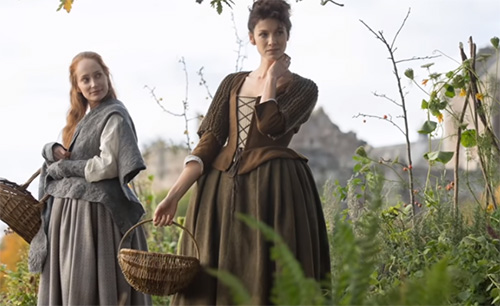
This is what Brenna Barks has to say, “Look at houses of the time period for the average person, and you will notice they rarely had wardrobes or many places to store clothes. This is because they didn't have a lot of clothes to store… The average woman would typically have worn a large skirt (possibly multiple to keep warm and get the bulk at the hips that was in vogue at the time – just because they were poor and hell and gone from London doesn't mean they didn't have some sense of the fashionable silhouette) and a bodice of simple wool, and an arisaid which is, basically, a big plaid/blanket worn about them like a cloak or shawl”.
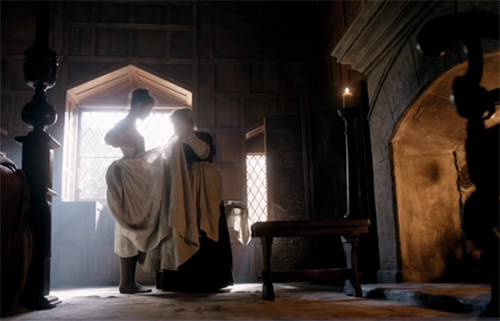
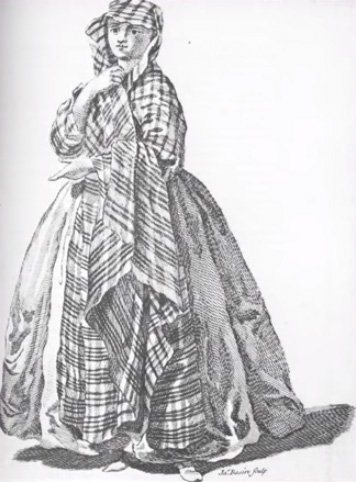
A Town Lady, James Basire, 1745
Here's an example of a mid-18th-century woman's costume, as depicted in this sketch by Scottish artist Allan Ramsay. This ensemble includes a fichu, which is a triangular-shaped neck scarf tucked into the bodice, and a cap. Under her outer clothes, a woman would have worn a linen shift or “sark” (which is Scot for a “chemise”), and a set of stays.
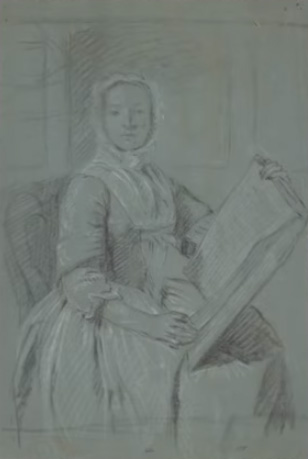
A Lady Holding an Open Book
Brenna Barks says that “the majority of the shirts and shifts at this time would have been made from linen, rather than cotton lawn – linen was a thriving industry in Britain. Especially since cotton was banned as a threat to the native linen industry in both 1700 and 1721 (called The Calico Acts)”.
Jeanie Hume, Geillis’s lady maid, is dressed in attire appropriate for the time. Although we don't see them on principle female characters, with the exception of unmarried women, most women and servants would have worn a linen cap of some sort. The reason that we rarely see main cast wearing headdress is because it is a nightmare for the director of photography, because it creates shadows.
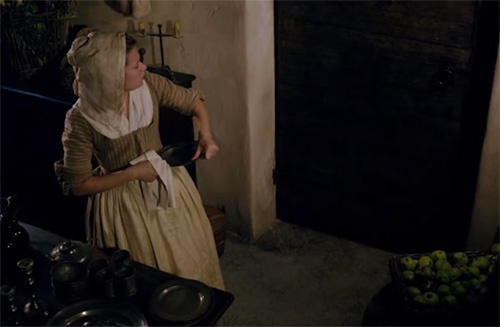
In a work by Scottish artist David Allan from 1790 “A Highland Wedding”, and while this is much later in the century, we see a variety of arisaids and caps on the women, including one mother (on the right) who appears to be using her arisaid to carry her baby.
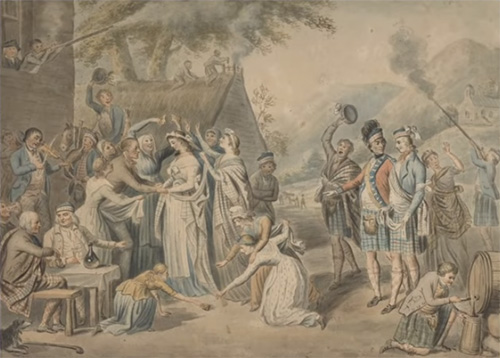
“I think most women would have worn a plaid of some sort”, Brenna Barks says. “Plaid is not necessarily a tartan piece of fabric but can simply mean a large width of cloth or a blanket. So even if they couldn't afford a tartan arisaid, they would have had one of plain material. It served as a sort of coat/cloak”.
This watercolor is after the Dress Act of 1746 was repealed, so it's hard to know if Allan was portraying a wedding from the time or from a previous period. Although Brenna says that the Proscription Act and whether their clothes were illegal when Allan painted them, it was actually very hard for them to enforce, especially in the smaller Highland communities.
In this David Allan painting “The Highland Wedding” from 1780, we also see an assortment of fichus and headdresses, including the kerch, a plain or tartan head covering worn over a fitted cap or coif. In some depictions, the kerch appears to be tied under the chin. And in the painting, the bride wears what looks like a ribbon hairband called a “snood”.
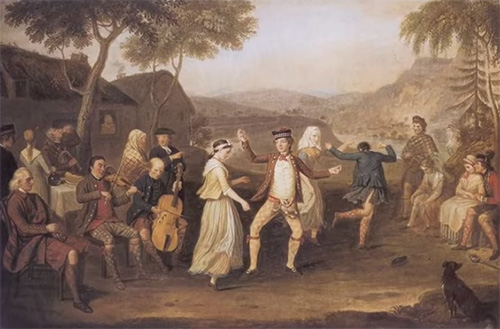
In this 18th-century painting by Scottish artist Richard Wait “The Henwife of Castle Grant”, the woman is wearing a kerch over a cap and a fichu pinned with an annular broach.
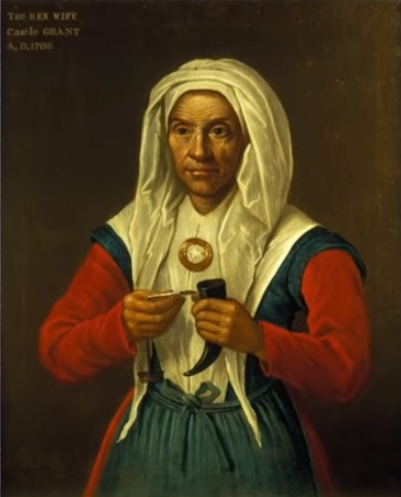
In this detail of an engraving of Scots women fooling cloth that’s stated circa 1770, we see a variety of women and girls wearing arisaids, caps, fichus, and snoods.
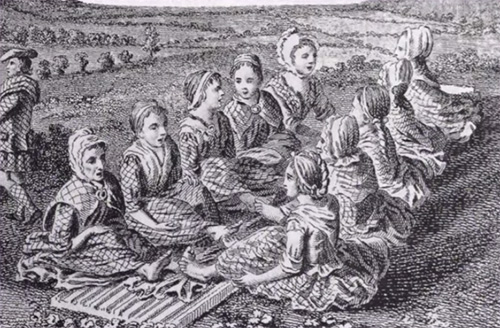
While costume designer of “Outlander” Terry Dresbach made the practical decision that her actors had to wear footwear, Brenna Barks says that this isn't actually historically correct.
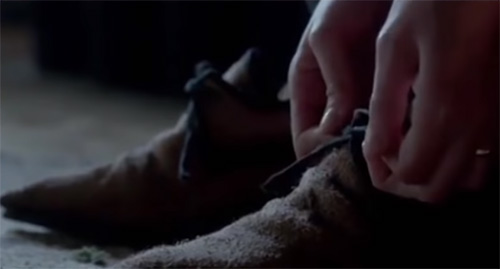
“The big inaccuracy (in “Outlander”) though: everyone had shoes. The accounts of the time period discuss people of both genders in Wales and Scotland as frequently being barefoot. Admittedly, all of these accounts must be taken with a grain of salt because of the tendency to “other” the Scottish and Welsh, but it is something that was notable and something else that we have forgotten used to be expensive: that's why there were cobblers, because shoes were expensive so you mended what was worn out rather than bought new”.
Brenna does qualify this by saying, “I suspect they did wrap their feet with rags based on practices by the poorer Britons in the Victorian era when we had photographs”.
Outlander costumes
And now let’s go back to the stage outfits of the Outlander girls.
Geillis Duncan
Geillis’s costumes are adorable, they are among the best in the series. This look is the first one we see on Geillis.
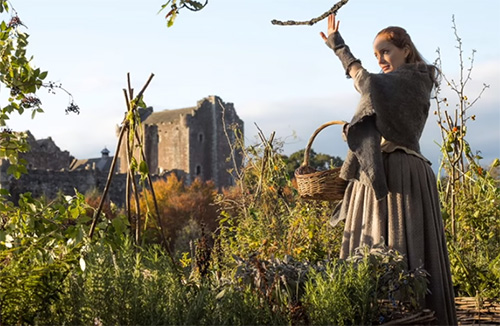
We learned in Season 2 Episode 13 that Geillis has gone through the stones wearing this same costume when she travels from 1968. Therefore, her outfit would have been created using modern materials, like we see with her shawl and also construction techniques.
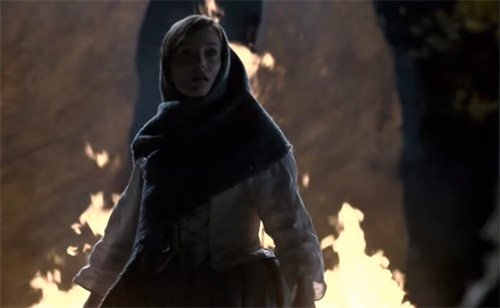

Sandie Russo from “Knitzy Blonde” says that the shawl that Geillis is wearing here, like many of her Season 1 garments, is created with a felting technique called “nuno”, which is derived from the Japanese word meaning “cloth”. Sandie says that nuno is a lovely technique that produces a rustic felted fabric.
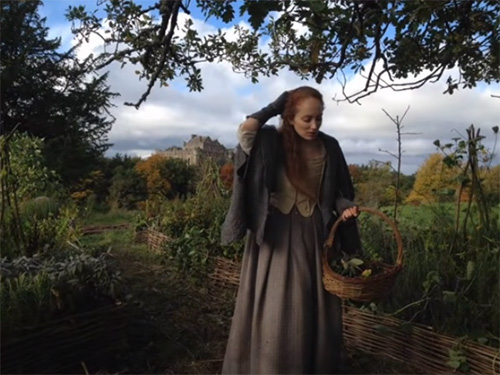
Sandie says that Dutch actress Lotte Verbeek “is funny, she likes playing with her clothing, so she actually put the thing on differently than Terry intended it to be worn. She put this one on her head when it wasn't meant to be that way”.
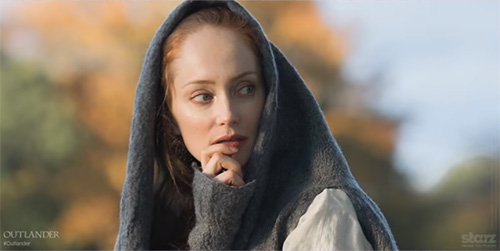
One remark is that Gillian wasn't wearing the mitts when she came through the stones and, by the looks of it, no travel bag to put them in.
Here's a great studio shot of the costume. Here you can see that the shawl is actually intended to be worn sort of like a serape.
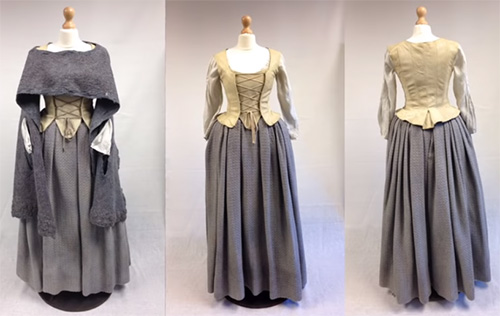
Here is a bodice from The Met in New York City with a very similar construction to Geillis’s leather bodice. This 18th-century bodice is made from cotton and is either American or European.
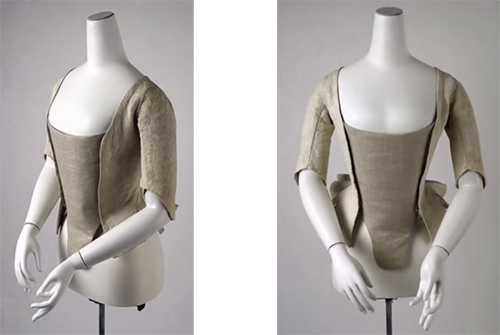
A fan favorite is this felted curly wool capelet that Geillis wears in Episode 3. It's also made from the same felting technique. With it, she's wearing what looks like a sleeveless linen bodice and pintuck-textured skirt.
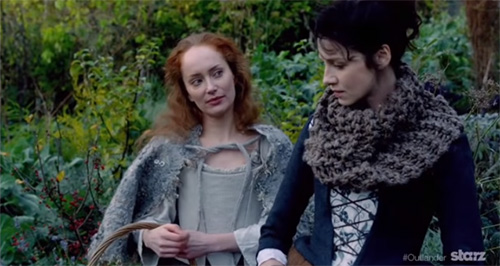
In Episode 10 “By The Pricking of My Thumb”, Geillis is wearing a sleeveless bodice, again in felted wool. From a distance, it looks like layers of feathers.

This is what Terry Dresbach says about the bodice that she calls “the monkey jacket”, “Oh how I love this piece. It is a felted waistcoat. The furry “spine” was supposed to go down the back and the waistcoat opens in the front. But Lotte said, ‘what if I wear it backwards?’ We turned it around and she started creepily stroking the spine. It was perfect”.
With it, she wears this lovely woven brocade skirt. “The skirt is this extraordinary skirt we made from a beautiful linen wool fabric from Ireland. The skirt is made with the wrong side out. At the last minute, I tied her sleeves at the elbow with a leather thong. It just seemed like the thing to do”, says Terry Dresbach.
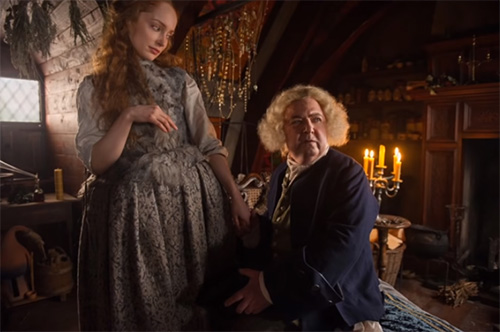
Here's a really great studio shot of actor Lotte Verbeek. The full skirt has deep pleats, and the additional fullness on the hips is achieved by a bum roll which she would wear under her skirt and petticoat.

Here's a great close-up of the bodice and the texture of the wool that's kept its fluffy texture through the felting process.
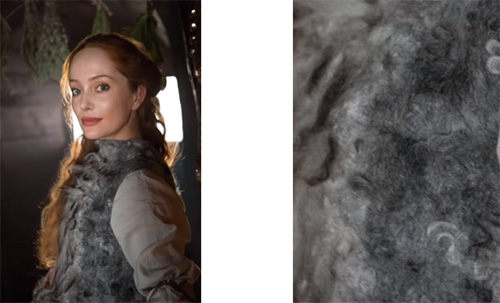
Geillis gets a bold shot of color with these crimson-red shoes. According to Terry Dresbach, it was happenstance that Geillis ended up with these shoes. Lotte saw them sitting on the wardrobe floor and inquired after them, and in a bit of kismet, Lotte tried them on and they fit her perfectly.
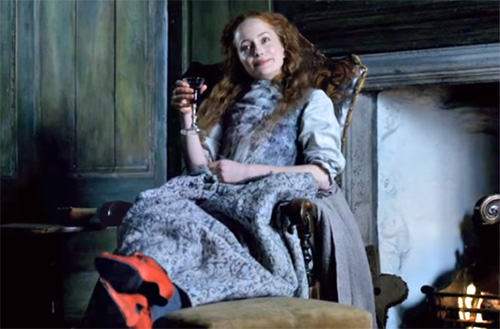
Geillis re-purposes the same skirt in Episode 10, when her husband drops dead from poisoning. She adds this matching bodice made from the same brocade. Although, it appears to be missing a stomacher. But as a woman of the 20th century living in the 18th century, she's decided that she can do what she dang well wants.
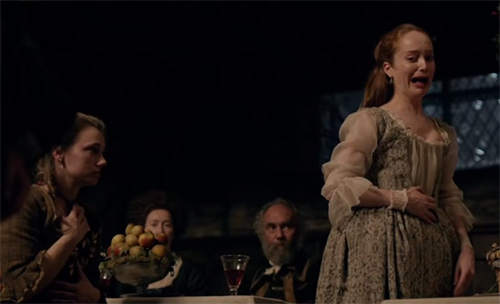
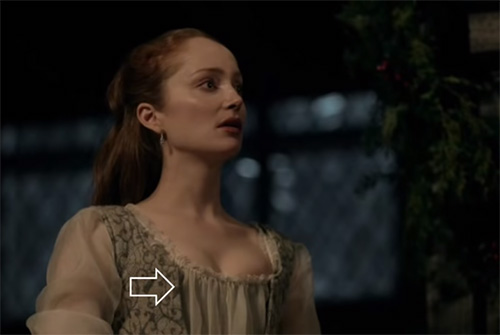
For this next costume, Terry Dresbach said, “I loved this costume. I designed Geillis as if she was always playing dress-up, always playing a part. That is why not one of her costumes connect as if they belong to one person. Their only theme would be that they make people slightly uncomfortable, but they are not entirely sure why. This costume is her Fiscal wife's costume. She comes to the castle looking “respectable”.
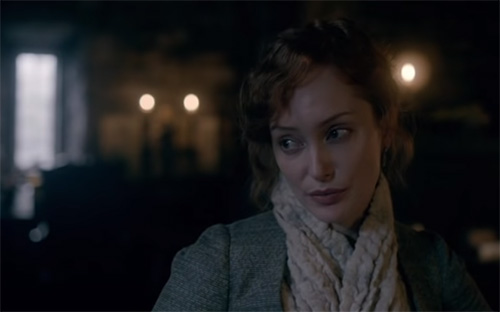
Terry Dresbach also said, “I am madly in love with her fichu, which is felted wool. Again, we were able to play with costumes that don't entirely feel like they are of the time. A bit disconcerting, but certainly within the realm of possibilities”.
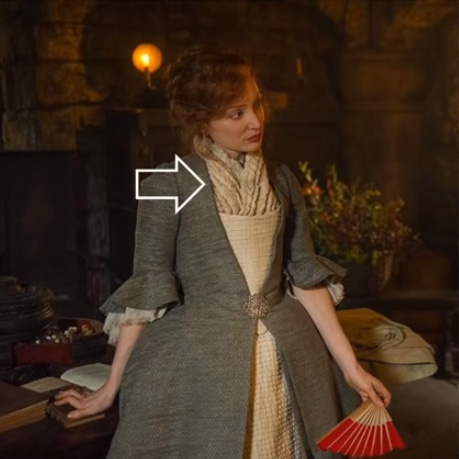
This is a close-up of the green velure, which is obviously not period-correct but so lovely.
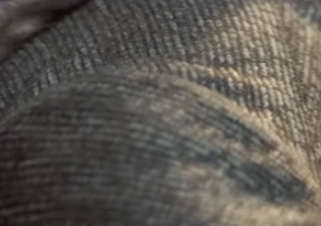
Here are some excellent studio shots of the costumes that Terry Dresbach shared on her blog. Both the stomacher and underskirt are flat-pleated to create additional texture. The felted fichu also looks like they've added tux. And Geillis’s jacket is similar to a caraco, which is a thigh-length style of jacket, fitted to the waist, with a center front opening and fitted three-quarter length sleeves or longer.
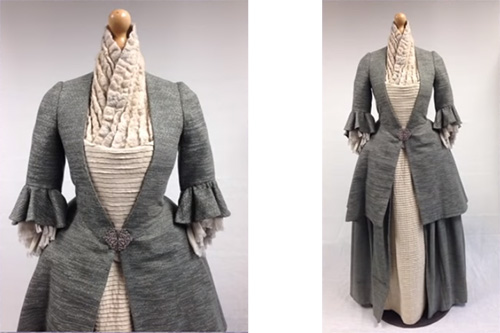
The fullness of the skirt of the jacket comes from these inverted box pleats at the back and side back seams.
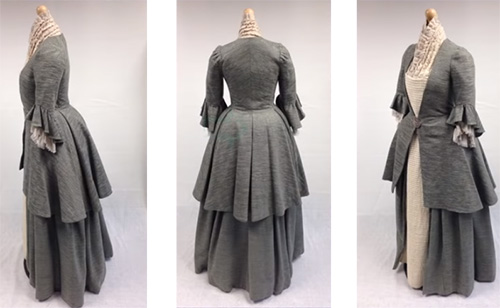
This Dutch cotton caraco is from the 2nd half of the 18th century and it's on display at The Met.
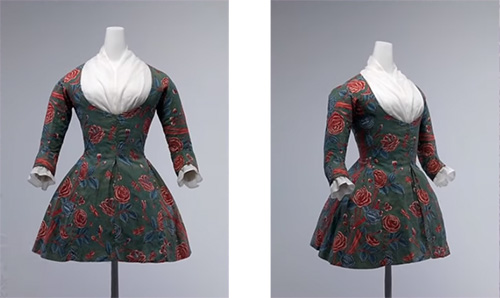
Like Geillis’s outfit, here is an example of a matching caraco and petticoat from the V&A in London. This British-made gown is constructed from cotton and dates 1770-1780.
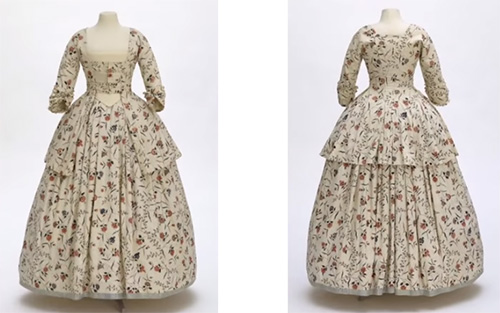
In Episode 4 at “The Gathering”, Geillis wears this memorable, not remotely historically accurate gown. Terry Dresbach said, “I was really sorry we didn't get to see more of the gown we made for Geillis in the Gathering”.
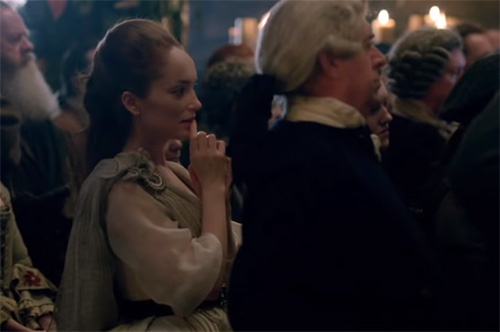
In these studio shots from Dresbach’s blog, she said, “It is a riff on an arisaid, or maybe better put, Geillis’s particular take on an arisaid. Once again, Geillis ‘plays with her clothes’. She is always playing dress-up, never the same Geillis twice. Geillis is always wearing a costume”.
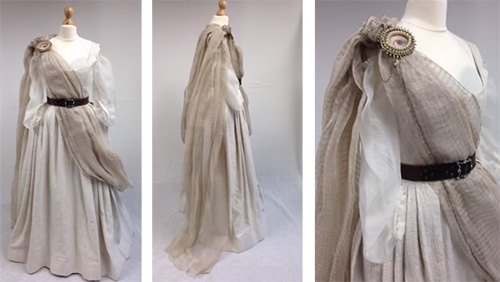
Also, Terry Dresbach said, “And YES, the eye brooch is purposely large. I made that choice, for the telling of the story. I know that the actual ‘lover’s eye’ brooches were much smaller… I have long been obsessed with Lovers Eye jewelry. I had one made for Geillis at the Gathering. Let me be the first to say that once again, to use one of these at the time of our story is inaccurate. Lovers Eyes did not show up for another 40 years”.
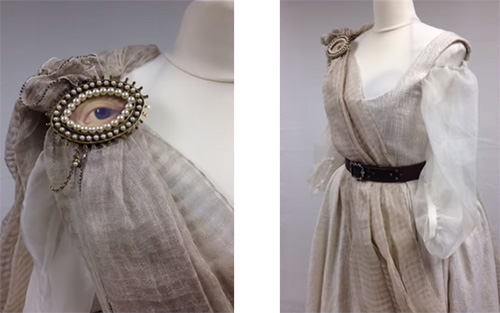
Here are two examples of Georgian Lovers Eye jewelry from an Ebay auction from a private collection. The shape on the left, by the way, is called a “witch's heart” – this shape used as a talisman to ward off evil spirits. In Scotland, this same shape was called the “Luckenbooth”.
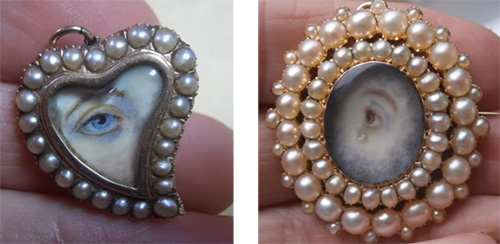
These two coats are Terry Dresbach’s favorite in the season. In another bit of kismet, Dresbach describes on her blog how this stunning Geillis’s jacket came to be, “The best part of the story is that we were planning an entirely different coat. We had chosen this amazing fabric, and were literally waiting for it to arrive. It was nail-biting time, and it was clear the day before shooting that the fabric was not going to arrive in time. One of those moments. You'd better figure it out, and fast. So we found this gold fabric on a shelf, but it was kind of dull.
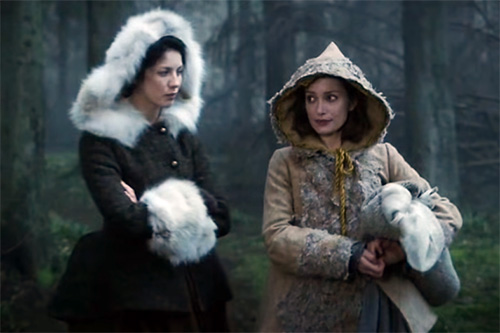
“So we added the decorative stitching. But it still said nothing much. This was Geillis in the woods with a Faery babe and Claire! It had to be special, and by this time it is the night before shooting. I look over on Liz's (our embroiderer) wall, and she has something pinned up there that looks like some sort of disease on the bark of a tree.

“‘What the hell is that?’, I ask our mad scientist. ‘Oh, just a wee experiment I did with scraps off the floor’, she says. Cut to the chase, we are all digging scraps out of the garbage and off the floor. No, I am not exaggerating. Before you know it, Liz is doing some weird felting technique on the machine. We are patch-working the bark growth onto this coat, and it finally starts to look like something. But it still hadn't completely harmonized. It needed some pop.
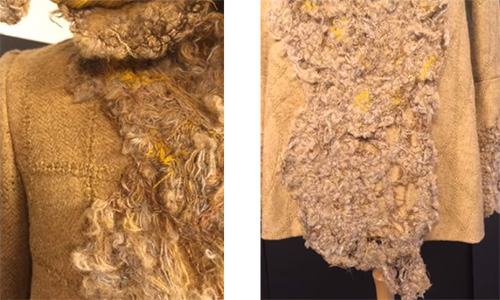
“I pulled out this yellowish/chartreuse thread, and had Liz work it into the mossy growth. Finally, we dyed cording to match for a closure, and there it was. When we put it on Lotte, it was absolute magic. That little point! It was gleeful, audacious, once again, Geillis challenges you! A perfect costume moment, created out of thin air, and some stuff from the trash”.
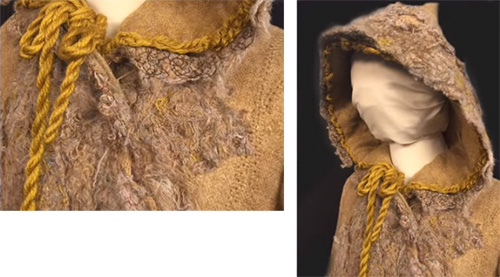
Here is Lotte Verbeek modeling the finished garment.
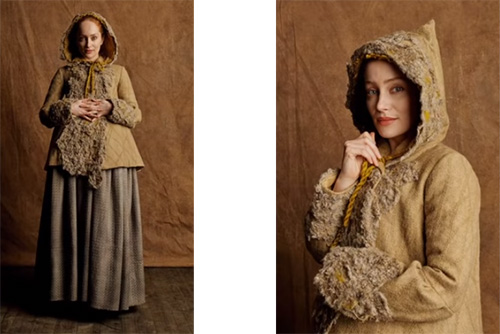
According to Terry Dresbach, the coat was modeled after this 18th-century garment – Capuchin-style jacket. This French jacket dates 1760-1770. The original is made from shaped taffeta, brocaded silk, spun silver, and silver lace flounces.
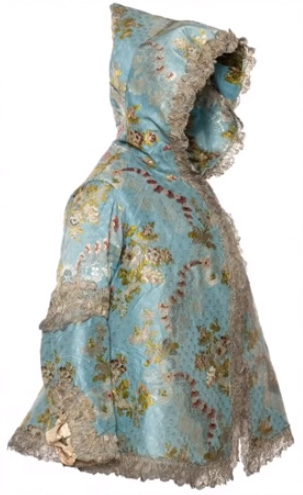
Terry Dresbach said about this costume, “There is a wildness and a freedom to this dress, a sense of abandon. It looks like it might fall off if you blow hard enough, or if she might just flap her arms a couple of times and float upwards. It has tremendous movement”.
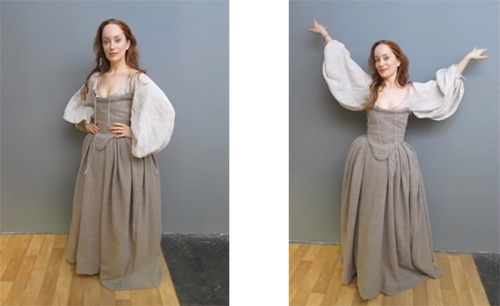
Dresbach also adds, “If you look close enough, you will see a plaid [tartan] we stitched into the bodice”.

Here is Geillis’s version of a mourning gown.
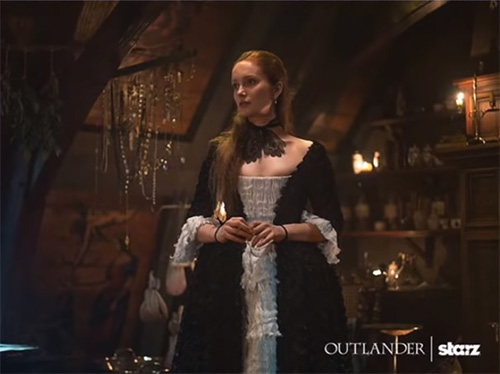
Terry Dresbach said, “I love this dress. We call it The Raven Dress, for obvious reasons. This dress is all about the materials. I was in a fabric store in London, and this fabric got up off of the shelf, and said, ‘Hey!!! I am Geillis’s widows weeds’. HAD to buy it, absolutely no choice. I had no idea what I was going to do with it, but there it was, and it was glorious. It looks like feathers. I have no idea what the fabric content is, it was an end of bolt special, but I know it doesn't have a natural bone in its body”.

Terry Dresbach added, “I started sketching. I knew I wanted it to be the most outrageous mourning gown one could imagine. And I knew I wanted white in it. Lots of it. We found this amazing white linen, that looked like sea foam. Put them together according to me ketch. There was no embellishment, the fabric was all the embellishment that was needed. It still wasn't quite right, it needed a bit more wild added in. So hit the white with scissors and started shredding it further, and wild emerged. The dress looked like it would fly away on its own.
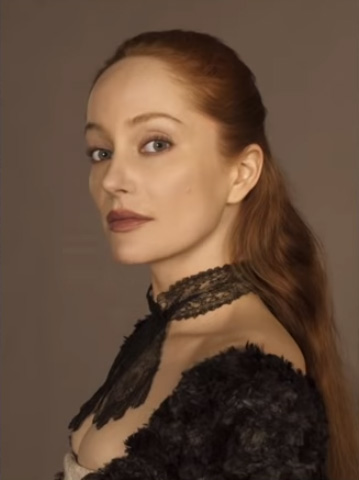
“The final touch was a pair of wings, made of a bit of beautiful black, antique lace I had been saving for a costume just like this. Pretty great stuff. If I do say so myself”.
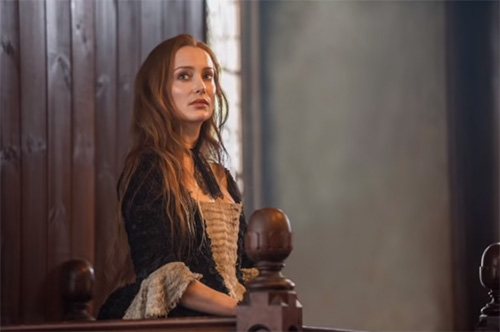
Jenny Murray (nee Fraser)
Jenny is a beloved character by most “Outlander” fans, and Terry Dresbach dresses her very well. Although her fabrics appear homespun, the quality and construction of her costumes show that she is the keeper of Lallybroch until her brother Jaime's returned.
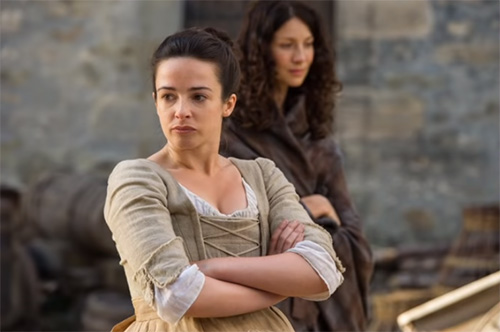
So, she's wearing a simple linen bodice with rough turned-back cuffs and a matching stomacher.
In this costume, Terry Dresbach chooses to put Jenny in undyed linen cloth. Perhaps because Jamie still considers her an innocent, in need of his protection.
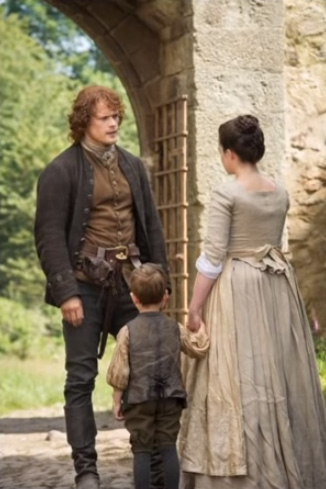
In this shot, she was wearing the same bodice but with a check woolen skirt.
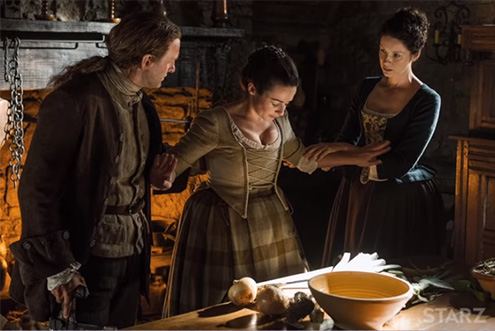
The skirt is flat in the front, with all of the pleats at the side and back.
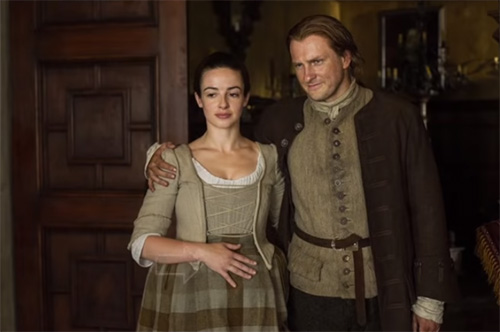
In this close-up on the left, you can see that Jenny tucks her stomacher into her skirt and only laces the bodice to the waist to allow for her pregnant tummy. The stomacher has additional boning to give it stiffness. And the metal hooks or loops, seen here in the close-up, are not period-correct. And on the right, is a close-up of the check woven fabric of her skirt.
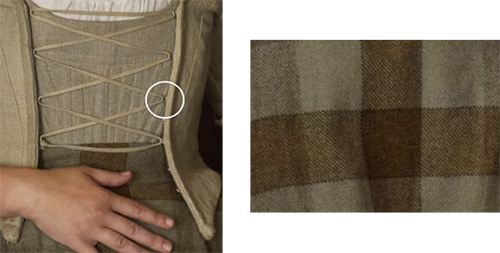
In this scene, she's once again wearing the same bodice. Although, it's wrapped with a linen fichu. And for some reason, she's wearing yet another woolen skirt – maybe this is her chores skirt.
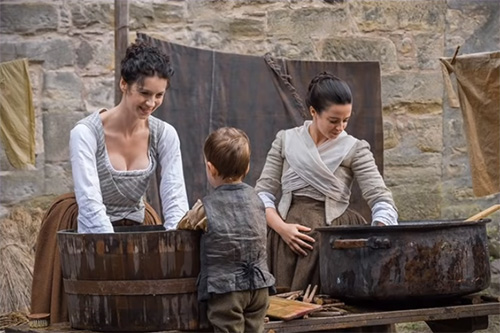
Here's a new bodice. This one is some kind of ribbed fabric that tapers to the waist and has flared tabs over the skirt portion. This is the same check skirt from the previous shot.

Finally, Jenny wears this look in Episode 14. She's no longer pregnant so she's returned to the tapered-waist full-hip silhouette. As a side note, in the 18th century, women would not have the luxury of maternity clothes – they would just loosen the laces of the bodices and stays, as we saw earlier.
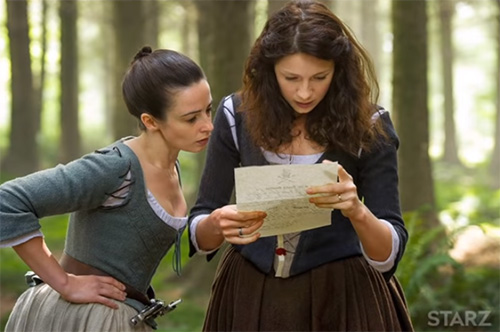
On the left, we see an embroidered detail on Jenny's tweed bodice. And the skirt that we see on the right appears to be the same lighter weight linen skirt from the other scene.
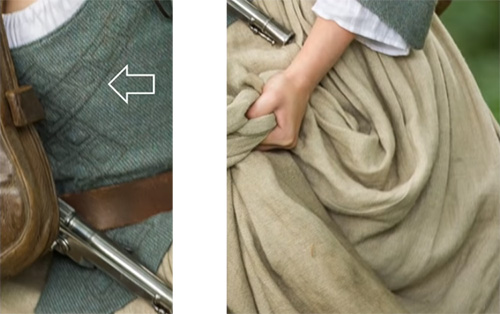
Here's a good shot at Jenny's detachable sleeves. They're attached with leather laces through hand-worked eyelets, which is period-correct. Metal grommets weren’t the thing until the 19th century. Thomas Rogers actually patented the metal eyelet not until 1823.
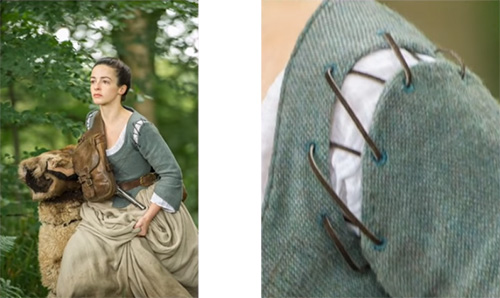
The laced on sleeves weren't common in Europe but they did exist to some extent. Here's an example of mid-18th-century silk stays from Italy. In this case, the sleeves are attached with ribbon ties.
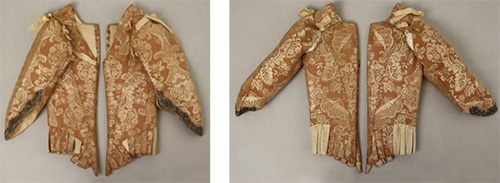
And here's another set of stays that date between 1720-1750. The sleeves seen here are attached with what looked like tabs.
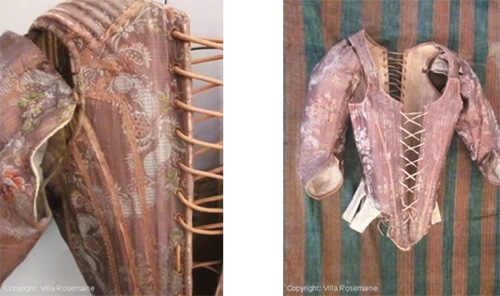
In these two 18th-century paintings by Italian artists, both of the women depicted here wear bodices with attached sleeves. On the left, is the painting of “A Girl in a Blue Dress” by Pietro Rotari from 1755. The model has sleeves loosely laced on. And on the right, is the painting “A Young Lady with Two Dogs” by Giacomo Ceruti. Here, sleeves appear to be tied on with ribbons or ties made from matching fabric.
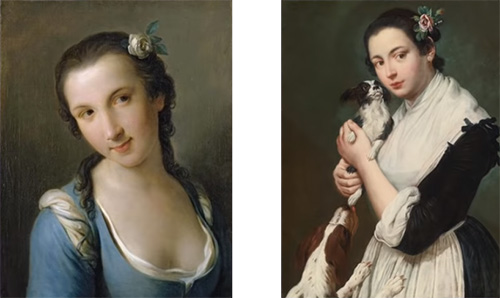
Finally, here is a pen and ink work by Scottish artist David Allan from 1770 titled “A Seated Italian Girl with a Crucifix” on display at the Scottish National Portrait Gallery. Again, we can see that her sleeves are attached with ties.
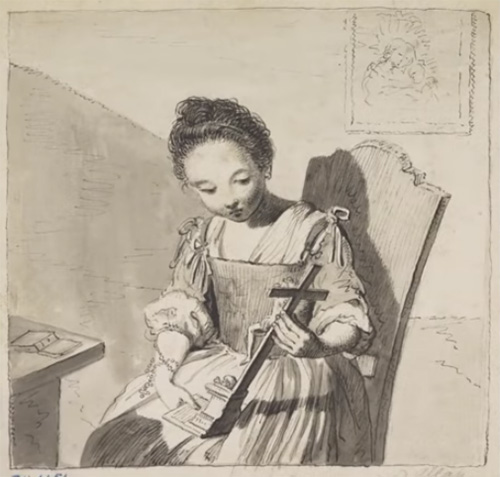
Though, Brenna Barks says, “These works, however, are not necessarily proof that the detachable sleeves were commonplace”. Their outfits may very well have been costume gowns, something they wore specifically for a painting. And as the clothing we see in portraits very well may never have existed, this is why historians get ridiculously excited when they find a surviving garment that was painted.
Finally, Jenny wears a woolen circle cloak with a hood. The fullness of the cloak comes from the gathers at the neckline where the hood attaches.
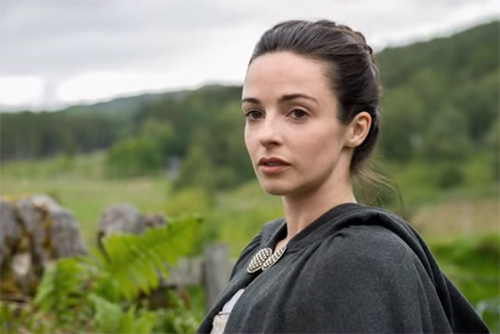
Laoghaire MacKenzie
This character is meant to be an antagonist, but still it’s a pity her costumes are far from beautiful.
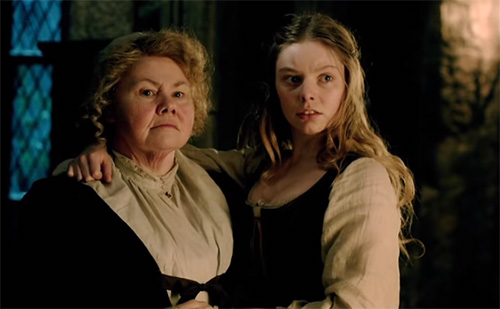
Laoghaire is actually meant to be 16 and yet it never feels that, since Nell Hudson, who is the actor that portrays her, is actually about 7 or 8 years older than that. And one thing that is especially off-putting is her stringy and greasy-looking hair.
Laoghaire’s costume feels far too drab as well. This sleeveless bodice looks black and Episode 2. But it’s more of a gray-brown tweed that's bound with – it might be – leather. And it doesn't look like she is wearing a busk, since it appears that always underneath her bodice is her stays and shift, which would be positively indecent, given that she is the granddaughter of the head housekeeper.
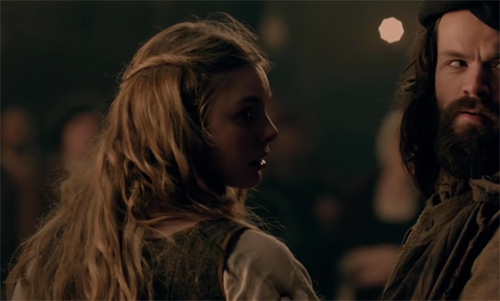
This costume, however, is one of the most awful of them all. It seems odd that Claire, who is an English woman and a guest of Colum MacKenzie (the laird of castle Leoch), would have clothes much finer than that of Laoghaire.
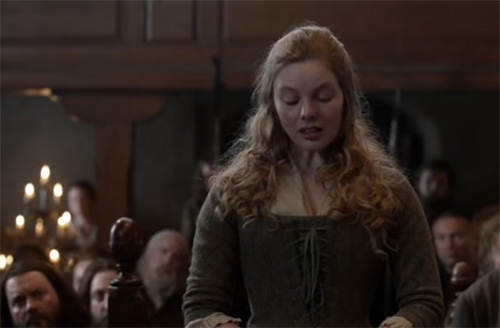
Here's a close-up of actor Nell Hudson wearing the ensemble. The funny thing is, here her hair looks so much better in this photoshoot than it ever looked in the actual show. And the color of the skirt might be a very dark green but again, in the show it reads black. The bodice is a Harris Tweed Herringbone, which is a fabric that hadn't been introduced yet and comes off too heavy-looking on an actor who has such fair and fine features.
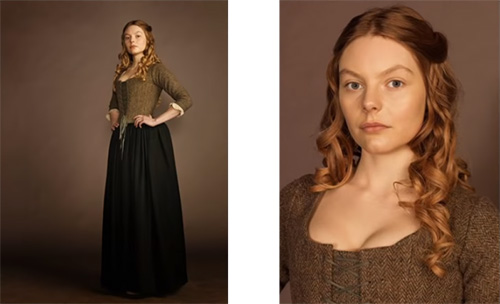
But the worst thing in this costume is this band at the bottom of the bodice. It's really unflattering. It would have been so much cuter with a little peplum or some tabs, like we saw on her other bodice.

Someone did this beautiful embroidered treatment on the stomacher and that odd band. The color matching her lacing, but it doesn't read at all.
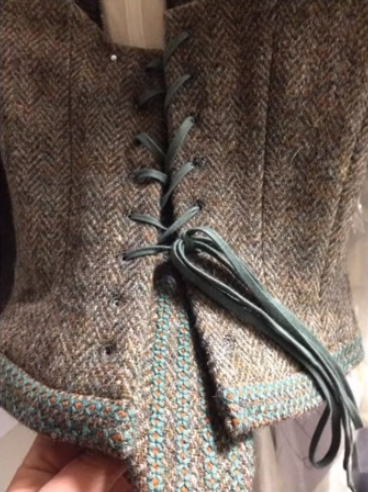
And this scene is interesting. It's like the 18th-century equivalent of a woman seducing a man, like we'd see Joan Crawford in “Dynasty” wearing a bustier and garters. So here, Laoghaire is wearing a pair of stays, which is a foundation garment for women. Stays would have been worn on top of a shift, but Laoghaire has gone out of her way to somehow get this thing on without too much chafing and bruising and also frostbite.
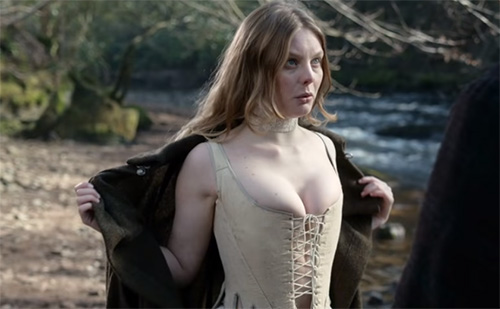
Here's an example of an actual Paris stays. This set of whalebone stays is from the 18th century, very similar to what Laoghaire is wearing. The conical silhouette and enhanced bustline is created with these rows of bone channels that taper the waist. And like Laoghaire’s stays, these ones lace in the front, but they would be more often laced in the back, like we see on Claire.
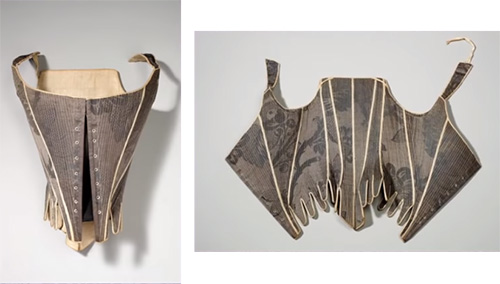
With this outfit, Laoghaire finally gets something pretty to wear. The color sort of hard to nail down depending on the light, but it's sort of in the light to medium blue range. The stomacher is a biased tartan pattern – this might be machine embroidered and not actually woven. And it might be that Laoghaire is long-waisted or that her skirt or bum roll is shifting down so that her bodice is sitting in a really awkward position.
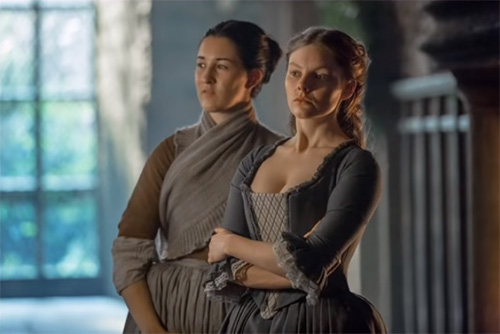
In this picture, Laoghaire’s gown color looks pretty because it picks up her eyes. The bodice might be trimmed with ruffles made from the salvage of the dress fabric. And her hair looks much better here, especially in the back.
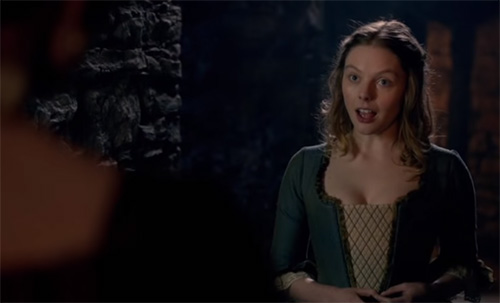
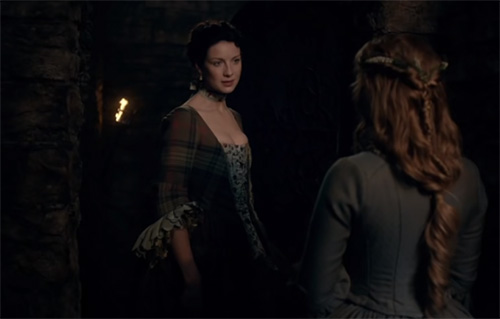
Mrs. Fitzgibbons
This Mrs. Fitzgibbon’s costume is lovely. Of all the costumes we've seen on the women, it appears to be the most historically accurate. She's wearing a brown woolen gown with linen ruffles on the sleeves, a linen cap and apron, and this neat collar that's sort of like a fichu but it's shaped more like a dickey. The dickey sits behind these ties from her dress, and the apron is tacked up at the hips. The only thing that is off are her mitts.

Brenna Barks says that the entire first season “the hand-knits really distracted me. This is because I am a knitter so that's one of the few things I can remake when it comes to historical garments”.

Here are a few caps in the period. The linen biggin on the left is British and from The Met in New York. Biggins were caps worn alone or as a foundation under another headdress. Although, children most often wore them alone. And on the right, from the V&A is a cap made from crochet linen or wool.
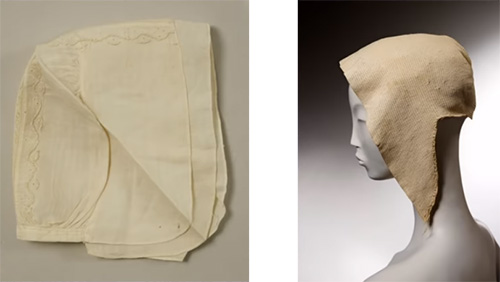
In Episode 10, Mrs. Fitzgibbons has another look in this light-brown bodice and matching cap with short tabs.
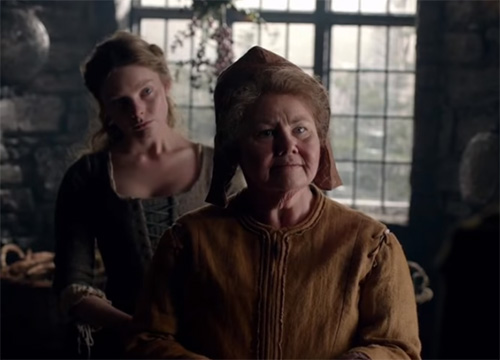
You can see that the sleeves are attached to the bodice with leather laces.
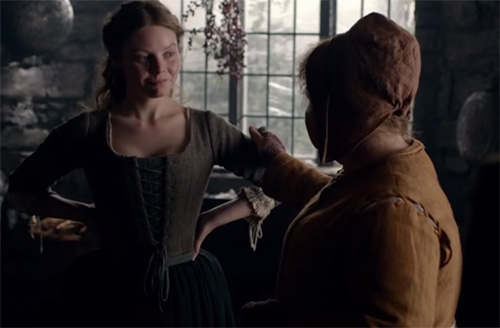
Letitia MacKenzie
As the wife of the laird of castle Leoch, Letitia McKenzie is a finely-dressed character. We first see her in this outfit in Episode 2 “Castle Leoch”.
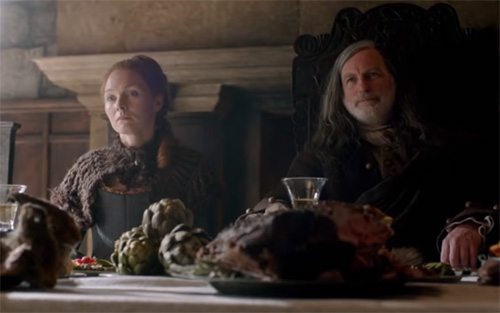
Terry Dresbach says of the character, “I get positively teary over Letitia. I loved her. I loved everything about her. We never saw her standing. She had some truly wonderful costumes. And her costumes were the first place I used a knit piece”.
In the studio shot of the costume, we can see that the gown is made from a wool fabric. The butterscotch petticoat and sleeve flounce is picked up from the subtle tartan weave of the dress.
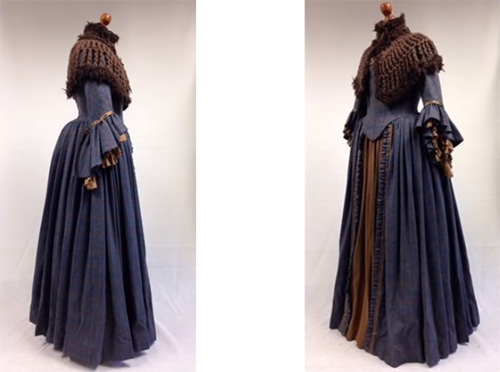
The gown is embellished with ruffles made from the dress fabric and a very pretty silk trim. It's hard to see, but the tartan is beautifully matched upon the bodice. Finally, the costume is finished off with a capelet, which Sandie Russo from “Knitzy Blonde” tells me is crocheted.
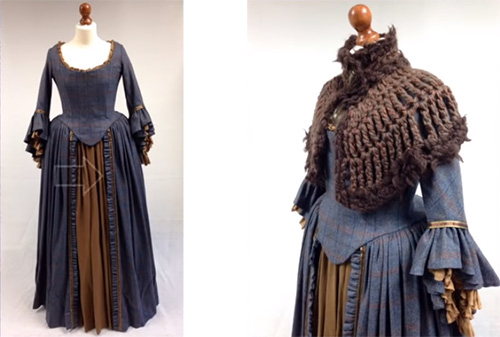
About the nets used in this series, Brenna Barks says, “Everything was too bulky, and they were clearly modern interpretations of garments at the time: lacy and other sorts of mitts were worn, but they weren't that chunky, usually more delicate; cowls and even scarves were not a thing, women would have worn shawls and fichus”.
Of course, Letitia's most memorable costume is this gorgeous butterscotch gown that she wore to the Gathering. The color of the gown is a close match to her auburn hair, which is styled beautifully here.
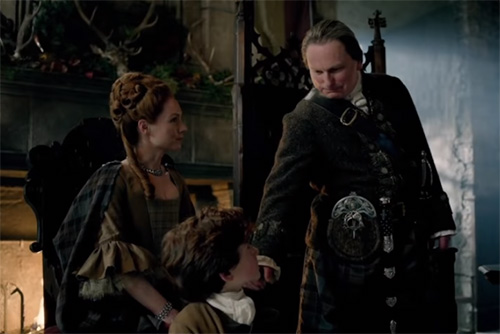
It's the first time we see an arisaid on a character, excluding Geillis, of course, who's Gathering costume is non-traditional. The arisaid is held in position by 4 brooches, two at the shoulder and two at the hip.
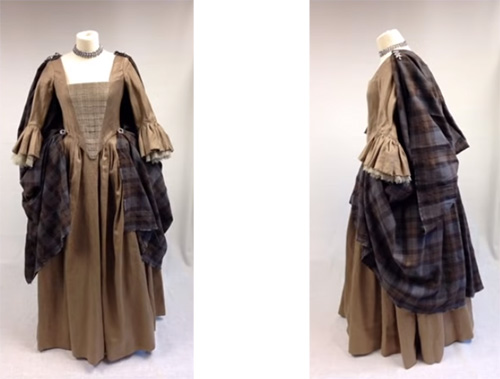
On the left, we can see that the stomacher has an overlay of this mesh fabric, which is the same fabric that's used in the flounce on her sleeves. And on the right, is a close-up of the McKenzie tartan arisaid, made specifically for the “Outlander” series.
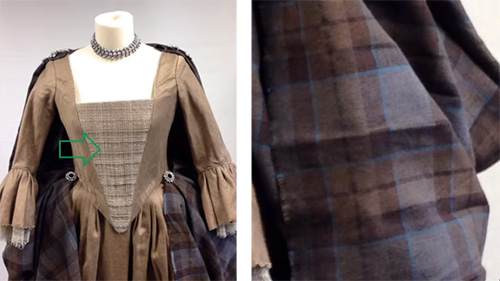
For reference, here's a painting of Elizabeth Gunning, Duchess of Hamilton, by Scottish painter Gavin Hamilton. In this 1752 portrait, the Irish-born famous beauty wears a gown with a wrap pinned at her neckline with what looks like a citrine brooch.
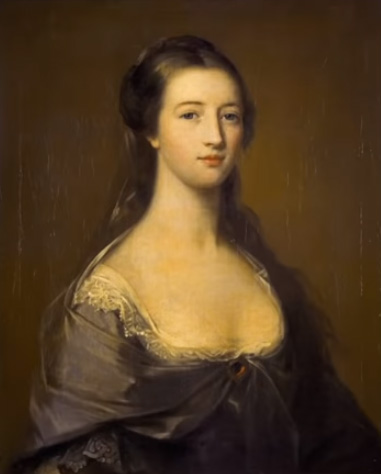
Here's Letitia's other gown. The one she wears to the concert. This gown is made from a burgundy windowpane tweed and the wrap looks like it's made from red fox pelts. The stomacher is quilted, and the gown is embellished with this flat-pleated trim. With a gown like this, the stomacher traditionally would have been held into position with pins, which are hidden in the folds at the front of the gown.
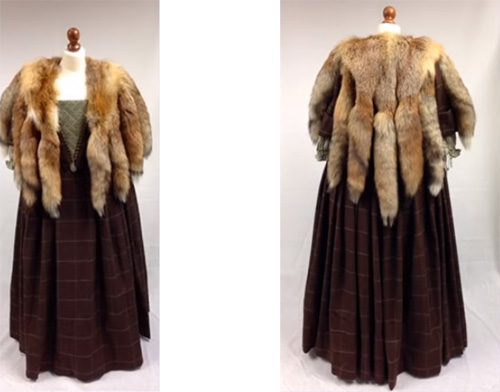
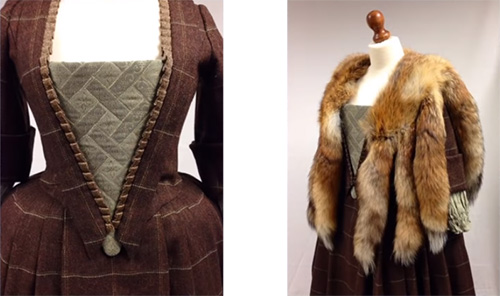
In this other portrait of Elizabeth Gunning from 1752 and again by Scottish artist Gavin Hamilton, you can see that she has the same folds in her dress to hide the pins that hold her stomacher in place. Both Elizabeth Gunning's portraits are on display at the Scottish National Portrait Gallery.
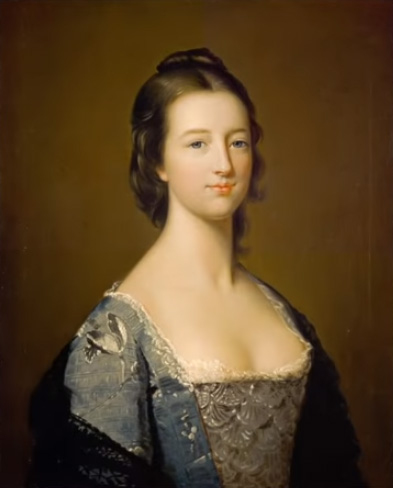
For reference, here are a few examples of the British sack gown, as it's sometimes called. This green&pink brocade-woven silk open robe is from the collection from the costume exhibit in Bath. The gown would have had a contrasting underskirt and stomacher. The one seen here is for display purposes only.
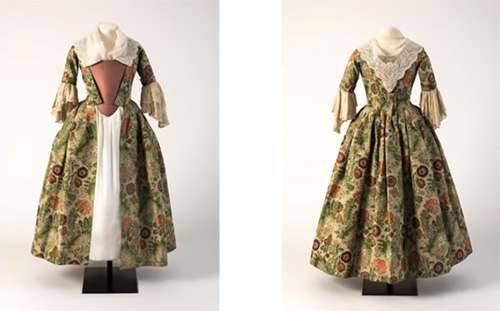
And while the French sack-back gown had loose pleats in the back, the strips of the British sack were stitched down to the waist, as we see on this dress.
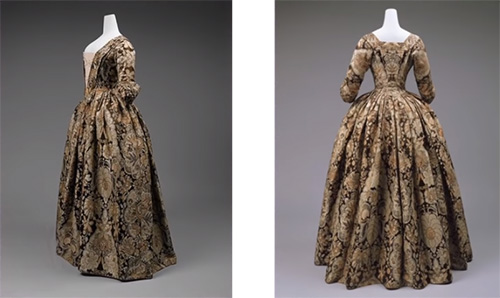
And that’s all for now. We hope you’ve enjoyed this material. We certainly did.
Read also:
Stage costumes of Outlander series, season 1. Scottish folk clothing on Jamie Fraser
Stage costumes of Outlander series. Men’s Scottish clothing used in this movie
(c)


